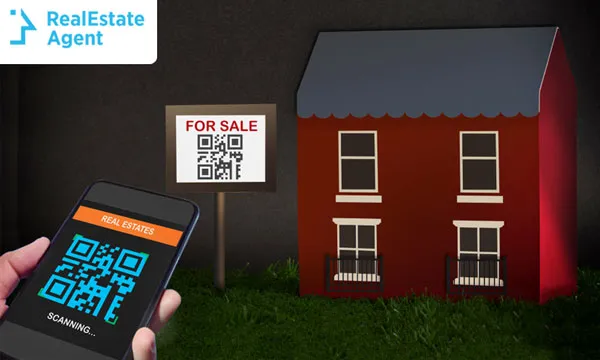 There has been a revolution going on when it comes to those traditional for sale real estate signs. Instead of the boring static old for sale real estate signs, savvy real estate agents and homeowners have been trying to improve curb appeal to lure clients to their home via modern high-tech smart “for sale” signs.
There has been a revolution going on when it comes to those traditional for sale real estate signs. Instead of the boring static old for sale real estate signs, savvy real estate agents and homeowners have been trying to improve curb appeal to lure clients to their home via modern high-tech smart “for sale” signs.
And thank God for that! For sale real estate signs have not changed much for more than a century. Always that bland square sign with – at best – the name of the person you’re supposed to talk to, the traditional for sale real estate signs are a marketing tool that became so omnipresent that it lost its effectiveness: we either block from our sights – we see it, but just don’t compute it because we know it’s advertising – or we become so annoyed by it that we start to come up with rules to diminish their presence. For instance, New Canaan Real Estate Agents have agreed to make a city-wide 6-months ban for real estate signs because they pollute the urban eye-sight landscape.
So, truly, a change was long overdue!
But what is this revolution exactly? Are we getting rid of the lawn signs, just like New Canaan Real Estate Agents did?
Not really. Actually, it’s the contrary.
In a way, for sale real estate signs are not doing anything special; they’re entering the new century, that’s all. Yes, their shape is different, but the real revolution is not about the way they look, but the service they provide. It’s all about functionality. What real estate agents realized is that the sign on your lawn should not only “advertise” the property, but go further a few steps to try and actually turn the passerby into a lead; if not for that property, for another.
Here’s the thing: 1 out of 10 people that do look at those signs and compute the information that the house is being sold and, coincidently, is currently looking for a house like that, do get the number and call the agent. That’s a very small number. So the real estate industry, taking advantage of the connectivity mobile phones and internet has allowed, decided to work on ways to make the sign go beyond a little bit. At first, it was just the addition of a specific QR code for real estate. The client would scan it and it would take him to the page in which that house was listed. This simple action was a revolution in itself because now the client could get – without bothering the real estate agent – standard information like square footage, year of construction, the asking price, the agent’s telephone number etc. The life of a real estate agent is a busy one, so, if time is money, QR codes for real estate became a real money saver; especially because this one was so simple – just a URL redirection - that real estate agent could do and program it themselves.
Now, technology development leads to even more amazing technology development, so it didn’t stop there, and QR code for real estate went from money saver to money-maker. With a bit more programming, real estate agents became able to provide social media subscribe buttons and contact information, which, you can imagine, increased their number of leads significantly. With a simple scan from the curious minded, they could get a call or a new social media follower.
QR codes for real estate are so easy and effective there’s no good reason not to add it to a real estate for sale sign, however, the real revolution is what came out of the continued use of it.
Seeing how agents were getting great leads, real estate startups started to invest in modernizing the signs even further and the result was amazing. The so-called “smart signs” have it all. First, they are round, which, in itself, is already a disruption. They have motion sensors: whenever someone walks within 20 feet of it, the smart sign’s LED lights up. Sure, those cosmetic changes are nice in itself, and it makes the signs stand out. But what’s great is what the sign, if aligned with a specific app, can do: connect the client with the agent via Bluetooth, a tool where you can directly schedule a showing, or even, a digital lockbox for the buyer’s agent to open the house and show it to his client. If you are away from it, the app can open Google maps and point directions to the place. For the future, once you add voice recognition and artificial intelligence to it, there’s a whole field of CRM (customer relationship management) that will be able to be done by the sign, alleviating you and your real estate team of those duties, letting you focus on the analysis of data, rather than the collection of data.
Is it perfect? Does it come with no possible problems attached? Of course not.
First off, it’s fairly expensive. Different from the QR codes for real estate signs, homeowners won’t be able to do it themselves; they will have to pay these companies that are on the vanguard of it around $700 a sign. Of course, the price will drop as soon as the demand increases, but still – and here’s the second point – with so much expensive state of the art technology inside them, it’s pretty possible that people will try to steal it. Companies say their insurance policies are in place to take care of that, but just the nuisance of having to deal with it (or even worrying about it, really) is something to take in consideration that both the QR codes for real estate and traditional for sale signs didn’t bring along.
Aside from the financial aspect of it, there are also nuisances regarding the signs itself. However cooler they are, there’s already a whole anti-visual pollution movement from which the smart signs will hardly escape. And, having motion sensors, it will routinely light up in the middle of the night because of birds, stray cats and other animals, which, combined with the anti-visual pollution movement, can become a sound argument and give the homeowner a lot of headaches.
There will be workarounds; this is all very new, exciting and bound to provide a lot of conversation topics for the real estate industry. What are your thoughts on it? Are you like “How do I get a QR code?” because you thought this was a great idea? And what about this new way of looking at for sale signs? Do you think it will be perennial or do you think that, with digital modern marketing constantly winning in the Old-School Marketing vs. Modern Marketing debate, the days of “for sale” signs are over? Tell us in the comments!
















Have a question or comment?
We're here to help.